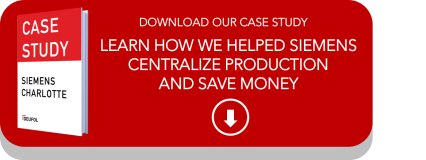Improving efficiency is a constant effort for most manufacturing and industrial companies. Far too often, though, the effort is focused only on technical components, like machine speed or waste. The truth is that your biggest boost in efficiency can come from examining your most valuable asset - your people.
 Here at Deufol, we’ve done exactly that. Over the past couple of years, we’ve examined our people and how our process facilitates their ability to innovate and improve. We have looked at how much authority our workers have to solve problems and implement solutions. And we have spent a substantial amount of time looking at how we can allow our managers to do what they do best - manage and support their teams.
Here at Deufol, we’ve done exactly that. Over the past couple of years, we’ve examined our people and how our process facilitates their ability to innovate and improve. We have looked at how much authority our workers have to solve problems and implement solutions. And we have spent a substantial amount of time looking at how we can allow our managers to do what they do best - manage and support their teams.
The results of this effort have been nothing short of remarkable. The process started in 2014, when we initiated a review of our overall efficiency. We found that while we were strong in several areas, there were still improvements that could be made.
For the past two years, we’ve developed and implemented a plan to improve efficiency across several key areas. We just got our first round of results from the new processes, and our efficiency is up more than 20 percent.
How did we do it? Below is a brief synopsis of the five step process we used called DMAIC. If you’re looking to increase productivity and efficiency in your production process, the steps below could be a good starting point for you.
Also, if you’re looking for a packaging partner, you would be wise to ask questions about their efficiency and their process. After all, greater efficiency on their part directly correlates to cost savings and improved accuracy for you. We take that obligation seriously, which is why we’ve committed so much time and energy to such a big project.
Step #1: DEFINE
You can’t get anywhere without setting your destination. For us, the first step was determining what the problem was. What measures were important? What kind of improvement did we want to see in those measures?
When we examined our current process, we identified that some of our production lines had poor performance, and that supervisors had no information regarding the issues that occurred in those lines. Thus, we decided that our project key measures were packing efficiency and supervisor percent time spent on the floor. We then set improvement goals to those measures.
Steps #2 & #3: MEASURE & ANALYZE
The next steps were to collect and analyze the current state data.
We conducted detailed efficiency and downtime analysis at different levels - Plant level, Product families’ level, and Line level - to set the baselines and identify the top areas with poor performance. Also we noticed the downtime data was not always accurate and not being utilized. There was no clear way to see the issues in real time.
We conducted a supervisor assessment, noticing that our supervisor’s time was at a premium. We found that our supervisors and managers were bogged down with office and administrative duties. They were spending too much time putting out fires and too little time on our lines, working toward continuous improvement. They had no assigned tasks so every day was a different day due to reactive work.
This work took months to do and involved detailed assessment and analysis of our processes. When that work was done, though, we were able to create actionable goals.
Step #4: IMPROVE
The next step was to implement process improvements to remove the root causes.
Having goals is a great thing, but to reach your goals, you have to be able to determine whether you’re on track. Can you imagine going to a basketball game that didn’t have a scoreboard? Us either. It would be impossible for either team to know where they stood and how to make adjustments.
We needed our own scoreboard so our supervisors and team members could identify challenges and make changes in real-time. We implemented a visual management system, called pulse check stations, throughout our facility. These stations have worksheets that touch on the real time performance of each major area and help prioritize the tasks needed to hit our goals.
If a task is falling short of deadline or is missing on accuracy, the department supervisors and team members can take action and correct course. We also increased the frequency of department meetings. In 2013, our departments met on a monthly and weekly basis. In 2014, we add short daily meetings so teams could drill down on specific issues and make instant corrections.
In 2015, we took it a step further. Now, our teams have brief pulse checks every two hours. They quickly look at the task list, highlight issues and challenges, and prescribe solutions in real-time.
Perhaps the biggest change we made was in empowering our team members to implement change without direct manager oversight. As you can imagine, many of our pulse checks that happen every two hours occur without a manager present. It’s up to each department’s team to hold those meetings and make them productive.
 Of course, this kind of change didn’t happen overnight. We had to introduce and re-introduce the kaizen methodology of continuous improvement through extensive training and kaizen events. We had multiple kaizen events dedicated to this project.
Of course, this kind of change didn’t happen overnight. We had to introduce and re-introduce the kaizen methodology of continuous improvement through extensive training and kaizen events. We had multiple kaizen events dedicated to this project.
The result is that we now have team members who are empowered to show their talents and do their best work. Our supervisors are spending less time at their desks and more time on the floor supporting their teams.
Step #5: CONTROL
The final step was to determine how to sustain the process improvements.
We developed standards for each position called Leader Standard Work. These standards detailed the daily and weekly expectations for each leadership position. In addition, we developed process adherence audits that focused in Safety, Quality, Productivity, and 5S.
We can say that our team members are embracing their newfound independence and decision-making ability. Through their clear standard work expectations, process audits, and pulse checks, they’re able to identify issues that would be best resolved through management involvement. And they’re able to ask for the things they need to better do their job.
They might need more staffing on second shift. Or perhaps they want to change a few steps in a process to increase efficiency. The key is that now the team members who are on the front lines are able to bring questions and issues to management, rather than waiting for management to see an issue and make a decision.
It’s been a long, but fruitful process. We recently found out that we had hit all of our major benchmarks. Our packaging efficiency is up across the board. Our managers are more available than ever. We’re making fewer mistakes. All told, this process led to a 21 percent increase in efficiency, which exceeds our goals.
Improving efficiency is important to us for a few reasons. Most importantly, it allows us to better serve our customers. After all, we’re in the business of helping you be more efficient with your packaging and distribution. To do that, we have to be as efficient as possible.





Let Us Know What You Thought about this Post.
Put your Comment Below.